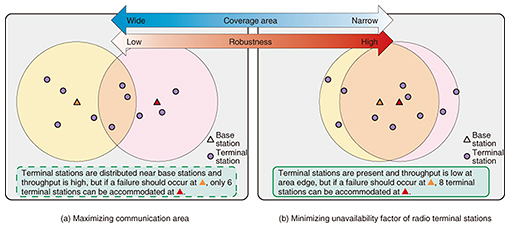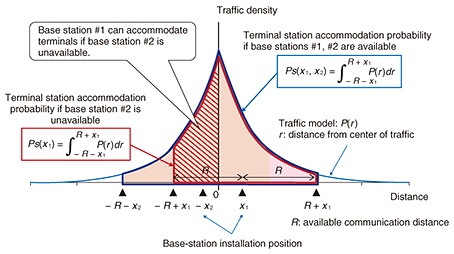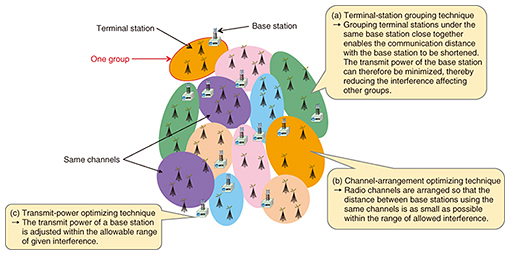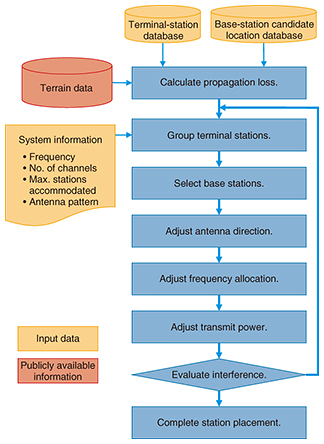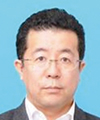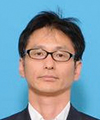 |
|
|
|
|
|
Feature Articles: Terrestrial Wireless Systems for Disaster Recovery to Provide Customer Relief Vol. 16, No. 1, pp. 59–64, Jan. 2018. https://doi.org/10.53829/ntr201801fa9 Cell and Radio Frequency Planning Tool Supporting Wireless Systems for Disaster RecoveryAbstractThe Great East Japan Earthquake struck Japan in 2011, causing widespread destruction and disrupting communication abilities. It has since been followed by other disasters, reaffirming the importance of having wireless systems available for disaster recovery. Although advances are being made in these systems, station placement design that can optimize the location of radio stations when a disaster strikes is also important. There is also a need for technology that would enable ordinary personnel to design station placement with the same results as that of a skilled designer. This article describes a means of simplifying the design of station placement at the time of a disaster by establishing guidelines and techniques that take disaster recovery into account and developing a tool for their application. Keywords: disaster recovery, station placement design, cell and radio frequency planning tool 1. IntroductionWireless systems for disaster recovery are especially effective in providing an early recovery thanks to the portability of the equipment and the provision of highly reliable communications using a frequency band oriented to disaster recovery. Various advances have also been made to deal with wide-area disasters that are predicted to occur in the future. These include point-to-multipoint communication, which enables a single radio base station to accommodate multiple radio terminal stations, and narrowband technology that increases the number of channels that can be used simultaneously. At the same time, it is becoming increasingly important to determine the optimum locations to install radio equipment (generic name applied to radio base stations and radio terminal stations) in order to effectively use an advanced wireless system. However, with the ongoing reduction in the number of personnel having specialized skills and the increasing difficulty of determining optimal locations for equipment installation, there is a growing need for technology that would enable even ordinary personnel to design station placement without needing to have the technical skills of a professional designer. With the above in mind, we have made it possible to use wireless systems for disaster recovery more effectively by establishing techniques for cell and radio frequency planning that takes disaster recovery into account and by developing a tool for applying them. This tool enables ordinary personnel to easily determine the optimal locations for installing radio equipment. 2. Station placement design policies considering disaster recoveryThe locations for installing radio equipment are determined according to policies and guidelines governing station placement design. Typical policies frequently established in mobile communications are set with certain objectives in mind, which include maximizing the communication area with as few base stations as possible and no dead zones (Fig. 1(a)), maximizing the communication capacity to accommodate more terminal stations, and supporting high-speed movement of mobile terminals to achieve smoother frequency handovers between base stations. However, station placement design policies that take disaster recovery into account are seldom seen anywhere in the world. At the time of a disaster, two policy objectives usually take on importance: (1) minimizing the unavailability factor of radio terminal stations by installing permanent radio base stations in a complementary positional relationship so that if one base station should fail another can accommodate more radio terminal stations, and (2) accommodating many radio terminal stations by reducing interference so that more radio terminal stations than usual can be accommodated by reducing the effects of interference. The following station placement design techniques have been established in order to put these policies into effect. 2.1 Minimizing the unavailability factor of radio terminal stationsThis highly robust policy (Fig. 1(b)) for station placement design aims to minimize the impact of a previously installed radio base station that has become unusable due to disaster-related damage.
An optimal solution exists for determining the locations for installing two radio base stations based on traffic density (distribution density of radio terminal stations) and the probability of failing for each radio base station. In the study model shown in Fig. 2, the probability Pt of terminal station accommodation by two base stations can be given by the following equation. Here, x1 and x2 denote the locations of the two base stations, while parameter functions Ps(xl) and Ps(x2) each denote the probability of terminal station accommodation, and pf1 and pf2 denote the unavailability factor of each base station. Pt(x1, x2) = (1 − pf1)(1 − pf2) · Ps(x1, x2) + (1 − pf1)pf2 · Ps(x1) + (1 − pf2)pf1 · Ps(x2). In this equation, base-station unavailability factors pf1 and pf2 are determined by past results and by the disaster-recovery levels of the NTT communication buildings where the base stations are installed. Traffic density, meanwhile, is determined by the characteristics of the area in which the disaster has occurred (traffic concentration etc.). Determining x1 and x2 so that terminal station accommodation probability Pt is maximized makes it possible to minimize the probability of terminal station unavailability.
2.2 Accommodating many radio terminal stations by reducing interferenceA wireless system for disaster recovery, while capable of long-range communications, can experience interference if many units of radio equipment are installed. This is because the number of channels that each unit of radio equipment can support is limited, and failure to establish sufficient distance between radio equipment using the same channels can result in large mutual interference. There are several measures for reducing the effects of interference. A typical measure is to install a device (e.g., a filter) for reducing interference in the radio equipment itself, but this can increase the size of the equipment. However, interference can sometimes be reduced through operations that do not require the installation of new equipment. This can be done, for example, by (1) controlling transit power to reduce the amount of interference applied to other radio equipment, (2) adjusting the orientation of a directional antenna so it points away from other equipment, (3) allocating different radio channels from those of neighboring radio equipment, and/or (4) reducing the number of radio base stations (Fig. 3). However, determining how best to combine these measures is both important and difficult, which is why station placement design techniques are necessary.
To reduce the effects of interference through operations, the same channels must be reused at locations that are as close to each other as possible, which is to say that the amount of mutual interference needs to be reduced by reusing the same radio channels. This can be achieved by optimizing the combination of measures (1) to (4) above. First, terminal stations communicating with the same base station are grouped together at short distances from the base station so that the transmit power of the base station can be minimized and the interference affecting other groups can be reduced (Fig. 4(a)). Next, radio channels are arranged so that base stations using the same channels are placed as close to each other as possible within the allowable range of interference (Fig. 4(b)). Finally, the transmit power of each base station is adjusted so as to fall into the allowable range of given interference (Fig. 4(c)). These steps are the key elements of station placement design techniques.
3. Tool developmentStation placement design traditionally requires advanced knowledge in wireless systems and extensive skills in radio overall. At the same time, determining where to install radio equipment is becoming all the more difficult as wireless systems become increasingly diversified and sophisticated. For these reasons, developing a tool for applying station placement design techniques would be of great benefit since it would enable ordinary personnel to obtain the same results as a professional designer even without advanced skills. The process flow of this tool is shown in Fig. 5. With this tool, a designer can perform station placement design by preparing a database of candidate locations for installing radio base stations, a database of installation locations of radio terminal stations, and information on the wireless system.
4. Support of high-accuracy station placement designFor this tool, we have adopted the method described in International Telecommunication Union - Radiocommunication Sector (ITU-R) Recommendation P.1812 for calculating propagation loss, the basis for station placement design. This is a general method for estimating propagation loss in the very high frequency and ultra high frequency bands that takes into account terrain effects such as shielding loss and diffraction loss as well as ducting effects. It is used to calculate the terrain profile and evaluate loss for each propagation path with high accuracy. Another method uses a building database to calculate propagation loss with a high level of accuracy surpassing that obtained with the ITU-R P.1812 method. The tool that we have developed makes it possible to import calculation results obtained using different propagation-loss-calculation methods by preparing a propagation-loss database with an adjusted format. This feature enables station placement design with even higher accuracy. 5. Future developmentThe cell and radio frequency planning techniques and tool have been implemented for use with wireless systems for disaster recovery. The cell and radio frequency planning techniques are independent of the wireless system and can be adopted in various types of systems. In future research, the plan is to apply these techniques to systems other than wireless systems for disaster recovery. |
|









